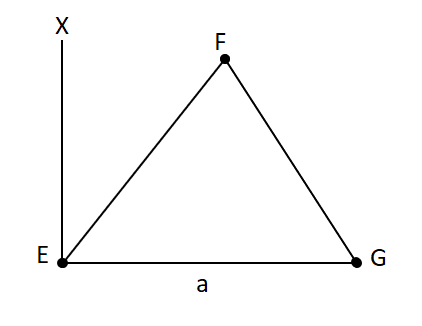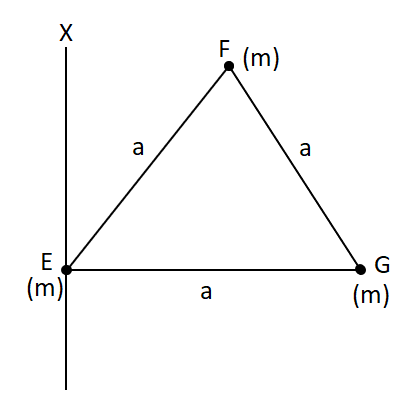
A massless equilateral triangle EFG of side ‘a’ (As shown in figure) has three particles of mass m situated at its vertices. The moment of inertia of the system about each line EX perpendicular to EG in the plane of EFG is (N/20) ma2 where N is an integer. The value of N is _____.

Answer
220.8k+ views
Hint:The Parallel axis theorem determines the moment of inertia of anybody about an axis which is parallel to the body passing through its centre is equal to the sum of moment of inertia of any given body about the axis which is passing through the middle and the product of the mass of the body times the square of the distance between the two axes.
Formula used:
Parallel axis theorem is given as,
\[I = {I_C} + M{h^2}\]
Where, I is the moment of inertia of the given body, \[{I_C}\] is the moment of inertia about the centre, M is the mass and h is the distance.
Complete step by step solution:
The mass of a particle situated at the vertex is ‘m’.
Moment of inertia of the system, I=(N/20) $ma^2$

Image: moment of inertia of the system about the line EX
According to the parallel axis theorem,
I=moment of inertia of triangle along the medium + \[m{a^2}\]
\[I = m{\left( {\dfrac{a}{2}} \right)^2} + m{a^2}\]
Substituting the given value of moment of inertia of the system, we have
\[\dfrac{N}{{20}}m{a^2} = m{\left( {\dfrac{a}{2}} \right)^2} + m{a^2}\]
\[\Rightarrow \dfrac{N}{{20}}m{a^2} = \dfrac{{m{a^2}}}{4} + m{a^2}\]
\[\Rightarrow \dfrac{N}{{20}}m{a^2} = \dfrac{5}{4}m{a^2}\]
\[\therefore N = 25\]
Therefore, the value of N is 25.
Note: Parallel axis theorem and perpendicular axis theorems both are used in conjunction to find the moment of inertia of a given rigid body about any axis. Both the theorems can be used to determine the moment of inertia of an object that is in rotational motion.
Formula used:
Parallel axis theorem is given as,
\[I = {I_C} + M{h^2}\]
Where, I is the moment of inertia of the given body, \[{I_C}\] is the moment of inertia about the centre, M is the mass and h is the distance.
Complete step by step solution:
The mass of a particle situated at the vertex is ‘m’.
Moment of inertia of the system, I=(N/20) $ma^2$

Image: moment of inertia of the system about the line EX
According to the parallel axis theorem,
I=moment of inertia of triangle along the medium + \[m{a^2}\]
\[I = m{\left( {\dfrac{a}{2}} \right)^2} + m{a^2}\]
Substituting the given value of moment of inertia of the system, we have
\[\dfrac{N}{{20}}m{a^2} = m{\left( {\dfrac{a}{2}} \right)^2} + m{a^2}\]
\[\Rightarrow \dfrac{N}{{20}}m{a^2} = \dfrac{{m{a^2}}}{4} + m{a^2}\]
\[\Rightarrow \dfrac{N}{{20}}m{a^2} = \dfrac{5}{4}m{a^2}\]
\[\therefore N = 25\]
Therefore, the value of N is 25.
Note: Parallel axis theorem and perpendicular axis theorems both are used in conjunction to find the moment of inertia of a given rigid body about any axis. Both the theorems can be used to determine the moment of inertia of an object that is in rotational motion.
Recently Updated Pages
Two discs which are rotating about their respective class 11 physics JEE_Main

A ladder rests against a frictionless vertical wall class 11 physics JEE_Main

Two simple pendulums of lengths 1 m and 16 m respectively class 11 physics JEE_Main

The slopes of isothermal and adiabatic curves are related class 11 physics JEE_Main

A trolly falling freely on an inclined plane as shown class 11 physics JEE_Main

The masses M1 and M2M2 M1 are released from rest Using class 11 physics JEE_Main

Trending doubts
JEE Main 2026: Application Form Open, Exam Dates, Syllabus, Eligibility & Question Papers

Derivation of Equation of Trajectory Explained for Students

Hybridisation in Chemistry – Concept, Types & Applications

Understanding the Angle of Deviation in a Prism

How to Convert a Galvanometer into an Ammeter or Voltmeter

Degree of Dissociation: Meaning, Formula, Calculation & Uses

Other Pages
Thermodynamics Class 11 Physics Chapter 11 CBSE Notes - 2025-26

JEE Advanced Marks vs Ranks 2025: Understanding Category-wise Qualifying Marks and Previous Year Cut-offs

Units And Measurements Class 11 Physics Chapter 1 CBSE Notes - 2025-26

NCERT Solutions For Class 11 Physics Chapter 8 Mechanical Properties Of Solids

Motion in a Straight Line Class 11 Physics Chapter 2 CBSE Notes - 2025-26

Laws of Motion Class 11 Physics Chapter 4 CBSE Notes - 2025-26




